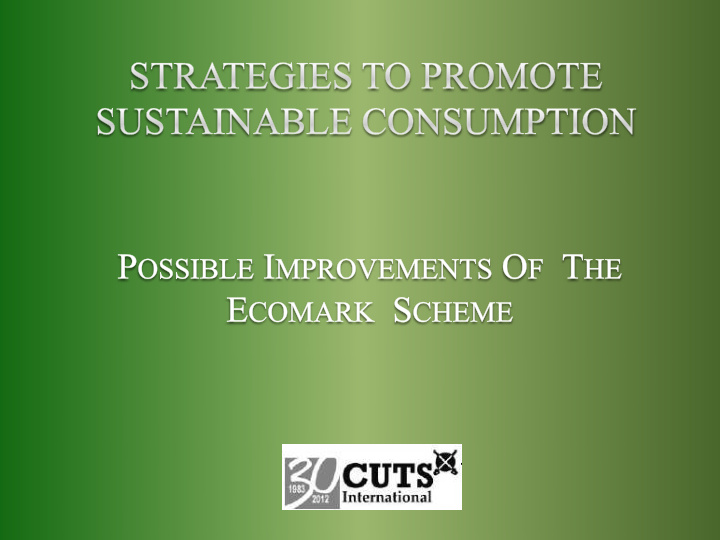



Successful Labels & Their Secrets In Green Seals (Type-3) experience, the process of commenting, discussing issues, and resolving issues involving all relevant stakeholders is most critical for the success of a standard – Green Seal, 2007 In Nordic countries success of Nordic Swan (Type-1) is due to the positive attitudes towards eco-labels among the industry, the consumer and environmental organisations - Consumer Policy and the Environment, 2005 Success of Blue Angel (Type-1) is to a large extent due to the contribution of media and consumer organisations – Ecolabelling: A case of deregulation, 2005
EU FLOWER LABEL ECOMARK SCHEME Product criteria revised every 3 No reference about revision years of criteria Develops Working Plan for every 3 Need for a forward looking years – an important strategic agenda planning tool Consultation forum [involving Limited provision for industries, SMEs, crafts, business external stakeholder organisations, trade unions, participation in the environment and consumer identification of product organisations] part of EU categories. While there is no Ecolabelling Board autonomous organisation.
Other countries’ experiences suggest that when sufficient support on credibility, consumer and market awareness, advertising and marketing are provided, ecolabels could be successful
Ways to Improve Ecomark Scheme Recommendations for revival of the Ecomark Scheme have already been made by various interested parties – Research report prepared by CUTS titled ‘Why was India’s Ecomark Scheme Unsuccessful?’ Brainstorming meeting on Reviving the Indian Ecomark, 2007, Organised by SAG, CERS and GTZ India Need is to zero-in on the most appropriate recommendations and decide upon how to address them to take forward.
CUTS Put Forward Few Policy Recommendations (Refer Mehta, Pradeep S (2006), Why was India’s Ecomark Scheme Unsuccessful?, Accessible at: www.cuts-citee.org/PDF/060909IES.pdf Need for a new, independent board with an advisory structure comprising of consumer, environmental and business groups. Need for a reduction and prioritisation of the number of selected product categories. Product categories chosen should be based on certain measurable parameters such as maximum adverse environmental impact and high national consumption. Objective of the Scheme should include – To promote trade across borders
Environmental groups need to be specifically involved in the Steering and Technical Committees of the Scheme. Scheme should be managed by specialist who can remain in the institution till task is well accomplished. Certification and licensing procedure needs to be more simplified. Need to de-link the ISI mark from the Ecomark
Scheme needs to be made more dynamic and forward looking by periodic revisions of criteria through wide stakeholder consultations. Need to rethink about the Logo due to the message it conveys. Period of license should be extended to two or three years. Like in case of Nordic Swan Label, Blue angel label Need for an effective National Awareness Campaign about the scheme. Need to create a one- stop interactive website for the Ecomark scheme, modelled on the lines of the EU Ecolabel, or oeko-tex label
Besides … Better to initially go for the licence fee waivers, discount in testing charges etc., to attract industry participation. There should be provision for lower application fee for the SMEs, and eco- friendly traditional producers. Government procurement should give preference to ecolabelled products
Thank You! Simi T B stb@cuts.org CUTS International
Recommend
More recommend